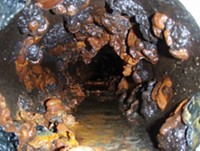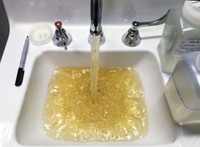Advertisement
Grab your lab coat. Let's get started
Welcome!
Welcome!
Create an account below to get 6 C&EN articles per month, receive newsletters and more - all free.
It seems this is your first time logging in online. Please enter the following information to continue.
As an ACS member you automatically get access to this site. All we need is few more details to create your reading experience.
Not you? Sign in with a different account.
Not you? Sign in with a different account.
ERROR 1
ERROR 1
ERROR 2
ERROR 2
ERROR 2
ERROR 2
ERROR 2
Password and Confirm password must match.
If you have an ACS member number, please enter it here so we can link this account to your membership. (optional)
ERROR 2
ACS values your privacy. By submitting your information, you are gaining access to C&EN and subscribing to our weekly newsletter. We use the information you provide to make your reading experience better, and we will never sell your data to third party members.
Water
Water treatment failures drove Newark’s lead crisis
Insufficient corrosion-control methods resulted in the neurotoxic metal leaching from the city’s pipes
by Giuliana Viglione
August 26, 2019

Under the hot August sun, Newark residents have been lining up for hours for their water allotment. Starting earlier this month, the city has been handing out two cases—48 bottles total—every two weeks to each of the 15,000 households that city officials have deemed are at risk of elevated lead levels in their drinking water.
Newark is the latest chapter of the urban lead crisis in the US. Like in Flint, Michigan, the neurotoxic metal ended up in Newark’s drinking water because the city’s water chemistry was not optimized to prevent it from corroding old lead pipes in its distribution system. This corrosion leaches lead into the water flowing to homes and schools. Now, one water treatment plant in the city is adjusting that chemistry to try to stop the corrosion, while experts try to figure out what exactly went wrong.
The Newark crisis first came to public attention in 2017, when the city reported that its lead levels exceeded 15 parts per billion, the regulatory limit set by the US Environmental Protection Agency. That year, the city’s annual water quality report assured residents that Newark had “some of the best water in the State of New Jersey,” even as it reported lead concentrations more than three times greater than the EPA limit.
In October 2018, faced with rising pressure from residents and groups like the Natural Resources Defense Council (NRDC), the city began distributing free filters to tens of thousands of households to remove lead from the water flowing out of their taps. Earlier that year, a city-commissioned study had found that corrosion control methods at one of the city’s two water treatment plants were not effective.
The Pequannock Water Treatment Plant, which provides more than half of the city’s water, had been using sodium silicate as a corrosion inhibitor since the mid-1990s. The exact mechanism of how sodium silicate works as a corrosion inhibitor is still unknown, but experts think it is two-fold. First, some water experts propose it forms a thin, gel-like layer on the inside of pipes, which prevents corrosion. The compound also raises the water’s pH, making it less corrosive and promoting the formation of insoluble lead-carbonate minerals that end up lining pipes instead of flowing out faucets. This dual mode of action makes it hard for water quality engineers to determine the conditions under which sodium silicate is most effective.
The EPA, city officials, and external consultants are still working to determine the cause of the corrosion inhibitor’s failure. In June 2018, the Newark Education Workers Caucus and the NRDC sued the City of Newark for violating the federal Safe Drinking Water Act by not controlling lead levels. According to expert testimony filed by Washington University in St. Louis environmental engineer Daniel Giammar in the ongoing lawsuit, a 1994 study by the city, which led to the development and implementation of the Pequannock plant’s corrosion control plan, did not accurately represent the city’s system of pipes and their susceptibility to corrosion. Nor, he continues, did the city conduct enough tests to provide confidence that the chosen plan would work. Giammar’s testimony cites “several deficiencies” with the corrosion control approach used at the Pequannock facility, adding that it is “not clear that the Newark water system ever had optimized corrosion control treatment.” By press time, C&EN was unable to get a response to this statement from Newark city officials.
Marc Edwards, a civil engineer at Virginia Tech, helped detail the extent of Newark’s lead problem in 2017. Based on reports he’s reviewed of how the city treated its water before the crisis, he says the Pequannock plant was running into problems feeding enough lime into the water it was treating. Utilities use lime to control the pH in their water distribution system, keeping the pH relatively high to prevent corrosion. As a result of not getting enough lime into the water, water at the plant became neutral or slightly acidic and corroded pipes as it flowed into consumers’ homes. Water quality reports from the city indicate that the pH of the city’s water has been dropping since 2012—from 7.88 in 2012 to 7.02 in 2018.
In response to the crisis, the Pequannock plant switched corrosion inhibitors from sodium silicate to the more widely used zinc orthophosphate on May 7 of this year. Plant operators made the switch because the phosphate compound has been effective in nearby water systems that handle raw water with similar characteristics, says Jerry Notte, who is the license holder for the facility and a water quality consultant to the City of Newark. Newark’s other water treatment facility had been using an orthophosphate inhibitor the whole time.
Unlike sodium silicate, zinc orthophosphate forms a mineral crust, known as a passivation layer, on the inside of pipes. It does so by reacting with metals released from pipes, forming insoluble precipitates. As this material builds up on the walls of the pipes, the resulting scale layer prevents further dissolution or oxidation of the metal, says Ashaki Rouff, an environmental geochemist at Rutgers University–Newark. An effective passivation layer can take months to develop in a water distribution system, Rouff says. In the meantime, lead levels may continue to rise.
Further compounding Newark’s woes, the city found problems with the free water filters distributed to households. Earlier this month, the city tested three of the distributed filters in homes; two failed to remove lead from the city’s water. As a result, the EPA issued a letter urging the city to provide bottled water to residents for drinking and cooking “out of an abundance of caution” until the cause of the filter failures could be determined. These filters, which had proved effective at reducing lead levels in Flint, are certified by NSF International to remove 99% of lead from water.
Rouff is puzzled by the filters’ failure. If there were high levels of other metallic ions in the water, she hypothesizes, those ions could have competed with lead for the active sites in the filter, reducing its effectiveness. Alternatively, simple installation errors or manufacturing defects could be to blame.
The EPA is currently conducting further tests to determine the cause and the extent of the filter failure. The City of Newark also just announced a $120 million plan to replace the city’s lead pipes in the next 24–30 months. For Newark residents, the big question is when will their water be safe to drink? “The expectation is it’s gonna take a while for that to occur,” Notte says. “No one’s exactly sure.”
CORRECTION
This story was updated on Sept. 5, 2019, to add information about comment from the City of Newark and the city's plan to replace lead pipes. The story also was updated to correct the name of the Natural Resources Defense Council and a quote from Daniel Giammar's expert testimony.





Join the conversation
Contact the reporter
Submit a Letter to the Editor for publication
Engage with us on Twitter